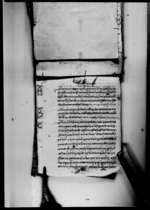A copy of a lālamohara from King Gīrvāṇayuddha appointing Gajabhāryā Ḍamāī as drummer at Gorkhā's dasaĩghara (VS 1863)
ID: K_0030_0036B
Edited and
translated by Astrid Zotter
in collaboration with
Pabitra Bajracharya
Created: 2019-09-10;
Last modified: 2023-02-22
For the metadata of the document, click here
The accompanying edition, translation/synopsis and/or commentary are available under the terms of the Creative Commons Attribution-ShareAlike 4.0 International License
Abstract
This copy of a lālamohara from the king, who according to the date must have been Gīrvāṇayuddha, appoints Gajabhāryā Ḍamāī to take over Dubalyā Ḍamāī's duties to play the nagarā drum of the goddess of Gorkhā's dasaĩghara and enjoy the attendant rights.Diplomatic edition
[1r]
1⟪२२६⟫1आगेगजभार्याडमाईकेगोर्षाकाडसैघरकाश्रीभवानीकानगरा2दुवल्याडमाईकोषाये़लवक्स्यौआफ्नाषातीरज्मासंगरुजभै
3भोग्येगरइतीमीतीसडर¯¯¯¯¯¯ ¯¯¯¯¯¯ ¯¯¯¯¯¯ ¯¯¯¯¯¯१
Translation
[1r]
2261
Āge: To Gajabhāryā Ḍamāī
We [hereby] confer [upon you] the nagarā drum of Śrī Bhavānī of Gorkhā's dasaĩghara [and] Dubalyā Ḍamāī's holdings (khāyela) [attached to it]. Be present [for the service], conscious of your duties, and enjoy [the attendant fruits].
The date2 is confirmed.
Commentary
The document was microfilmed twice; the second time as K_0344_0079.
The duties that came with being in charge of the nagarā drum of the goddess at Gorkha rotated more frequently between the two persons mentioned in the present document. On the 12th of the dark fortnight of Māgha in VS 1872 (26 January 1816), Gajabhāryā's rights were confirmed over those of Dubalyā, who had also raised his claim (K_0015_0004E). On the 11th of the dark fortnight of Āśvina in VS 1875 (26 September 1818) Dubalyā was reappointed to take over from Gajabhāryā (K_0015_0007D). On the 5th of the dark fortnight of Śrāvaṇa in VS 1876 (12 July 1819 CE) duties shifted back to Gajabhāryā (K_0015_0021B). The document from VS 1872 mentions 80 muris of jāgira land as being attached to the office as its emolument. In the one from VS 1876 the jāgira had increased to 1 kheta (i.e. 100 muris). This latter amount is also mentioned in a later appointment to the post on the 2nd of the dark fortnight of Jyeṣṭha in VS 1905 (20 May 1848, Vajrācārya and Śreṣtha VS 2037: 556). At that time, Ḍambaryā Damāi followed Kālyā Damāi in office.
The documents all refer to the position of nagarcī of the goddess Kālikā of Gorkha Palace. This person would not only be in charge of the deity's nagarā, a large kettledrum, but also be the leader of the musical ensemble of nine instruments called the nagarā bānā. This ensemble is still attached to the goddess Kālikā of Gorkha and plays for her worship during both Dasaĩ periods, when she is brought to the dasaĩghara, and on all aṣṭamī days as well, its lead drum, the nagarā, being redressed annually on the evening of the new moon day preceding the autumnal Dasaĩ with hide tanned from the left side of the satāra buffalo of the previous year (Tingey 1997: 100–102; Unbescheid 1996: 110).
In the documents, the name the deity is called by and the description of the post of ritual specialist differ. The goddess is referred to as "Śrī Bhavānī of Gorkhā" in the present document and in that of VS 1875 (K_0015_0007D), while she is called "Śrī Kālikā of Gorkha Palace" (gorkhā darbārakā śrī kālikā, K_0015_0004E) in the VS 1872 document and "Śrī Māī of Gorkhā" in that of VS 1876 (K_0015_0021B). The dasaĩghara is only mentioned in the present document. The person appointed is explicitly called a nagārci only in the later documents (K_0015_0007D, K_0015_0021B). Both K_0015_0004E and K_0015_0007D mention that he is in charge of "the nagarā together with the bānā" (nagarā bānāsmet), the latter probably the nagarā bānā ensemble.

